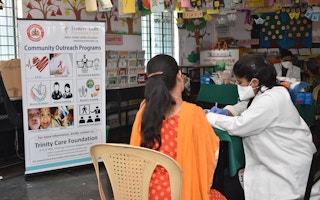Each morning on her daily commute, health worker Lalita Minj must navigate forests and bumpy roads to check on the health of some of India’s most marginalised people before they head out to work in the fields or mines.
Until recently, Minj and hundreds of female colleagues used public transport, rode their own scooters, or relied on their husbands to reach remote hamlets and provide basic healthcare in Jharkhand state, an eastern hub for coal and mineral production.
Across India, health workers have repeatedly held protests to demand better pay and highlighted how they sometimes even have to walk many miles to treat patients in far-flung villages.
But under a new state-led initiative to boost access to health services, particularly for communities affected by years of iron-ore mining in West Singhbhum district, Minj has now been provided with an electric scooter to make door-to-door visits.
“Even though I live within an 8 km (5-mile) radius of the villages I am in charge of, the ride to get there was never easy,” Minj, 40, told the Thomson Reuters Foundation by phone from her home in Chaibasa.
Before, she shared a petrol-fuelled scooter with her husband, so when he needed it she had no way of getting to work.
“
Hypertension is an underlying cause of many heart diseases and there is the stress of living with these levels of pollution that also takes its toll.
Tapas Chakma, scientist, Indian Council of Medical Research-National Institute of Research in Tribal Health
“Sometimes, he would drop me and we were spending a lot on petrol. The new e-scooter has solved both problems,” she said.
In Jharkhand, locals have for decades suffered from pollution caused by mining and related industrial activities, with researchers and rights campaigners pointing to rising cases of hypertension, respiratory diseases, malaria and malnutrition.
“The problems are endless - not just for communities living on the periphery of mines but also for those near the (coal-fired) power plants and other industries linked to mining,” said Savita Rath, a member of Jan Chetna, a community platform that aids mining-affected people.
“The land, water, air are all polluted. People are suffering, but have no easy access to healthcare. There is a shortage of staff in the primary health centres, medicines are often in short supply and ambulances are not available.”
It was during the Covid-19 pandemic, when health workers faced barriers to meeting vaccination targets, that the district administration took stock and did a regional “needs assessment”.
“We realised that our health workers needed mobility support, and it would be key to addressing all other challenges,” said Ananya Mittal, deputy commissioner of West Singbhum administration.
The area covered by each health worker is large, he noted, with some hamlets 3-4 km apart. The administration runs 342 health sub-centres and has made the same number of e-scooters available to staff so they can be reached easily, he added.
In the past, a few states like Telangana in the south have offered health workers subsidies to buy scooters. But under the West Singbhum project, launched in April, the authorities own the e-vehicles and lend them out to employees.
Pollution problems
A qualified auxiliary nurse and midwife, Minj is the first point of contact for villagers seeking healthcare or health-related information.
Her job includes recording maternal and child health, immunisation to control communicable diseases, treating minor injuries, health and nutrition education, and first aid in emergencies and disasters.
Many of India’s coal reserves and mining hubs are located in the central and eastern states of Chhattisgarh, Jharkhand and Odisha. They have large indigenous populations with limited access to government services.
Tapas Chakma, a scientist at the Indian Council of Medical Research-National Institute of Research in Tribal Health, said pollution caused by heavy truck movement around mines and contamination of water sources were key concerns.
A recent study assessing the health of villagers in Tamnar block in neighbouring Chhattisgarh state, co-authored by Chakma, flagged rising cases of hypertension, diabetes and tuberculosis in the area, which is home to a number of coal mines.
“Hypertension is an underlying cause of many heart diseases and there is the stress of living with these levels of pollution that also takes its toll,” Chakma said.
Many also point to the fact that healthcare workers can often only provide services in some of these regions once a month - something the state hopes to change with the provision of e-scooters that will help staff get around.
Tailored to their needs, the scooters have extra storage for medicines and first aid equipment, can be charged “as easily as a mobile phone”, and are simpler to manoeuvre on village roads.
The state is also looking at the possibility of setting up solar charging points for the scooters in the future.
Minj said it had previously been impossible to interact with patients and other locals on a daily basis, as she aims to do.
“Villagers often leave early for work and it is important for us to reach (them) at the right time to give them information or check on their health. The e-scooters have made it easier,” she added.
This story was published with permission from Thomson Reuters Foundation, the charitable arm of Thomson Reuters, that covers humanitarian news, climate change, resilience, women’s rights, trafficking and property rights. Visit http://news.trust.org/climate.








